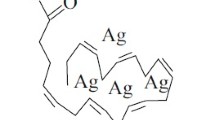Abstract.
Metallic gold (Au°) is a likely biotransformation product of monovalent gold, Au(I) whenever it is dissociated from in vivo ligands, Au° being formed either by bioreduction or by spontaneous dismutation (with co-production of trivalent gold). This review discusses the preparation and some biologically relevant properties of colloidal metallic gold (CMG) in its nano-particulate form. Tyndall’s purple, a well characterised preparation of CMG, shows potent anti-arthritic activity in rats, approximately 103 times that of sodium aurothiomalate (Myocrysin). Even more remarkable is its broader spectrum of action in rats compared to this classic DMARD.
Similar content being viewed by others
Author information
Authors and Affiliations
Corresponding author
Additional information
This article is dedicated to the memory of Michael Faraday (1791–1867), the father of electromagnetism and a truly remarkable chemist.
Received 4 July 2007; accepted 10 September 2007
Rights and permissions
About this article
Cite this article
Brown, C.L., Whitehouse, M.W., Tiekink, E.R.T. et al. Colloidal metallic gold is not bio-inert. Inflammopharmacol 16, 133–137 (2008). https://doi.org/10.1007/s10787-007-0017-6
Published:
Issue Date:
DOI: https://doi.org/10.1007/s10787-007-0017-6




